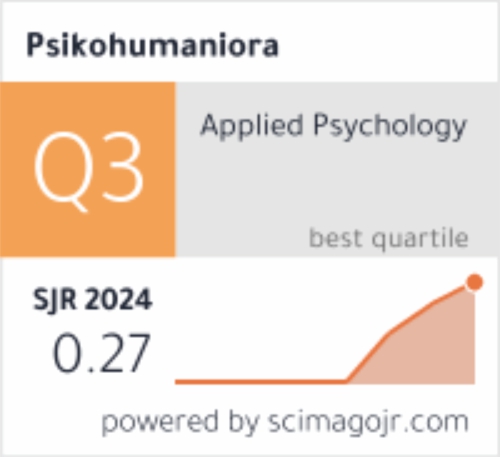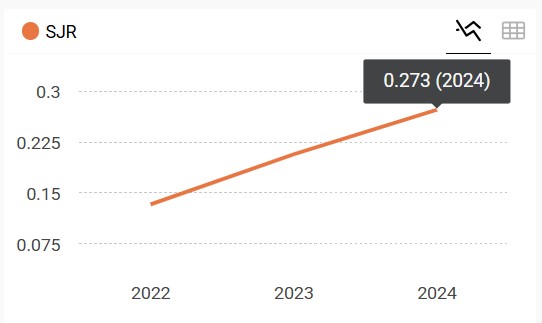The mediating effect of self-esteem on emerging adults’ materialism and anxiety
DOI:
https://doi.org/10.21580/pjpp.v5i1.5484Keywords:
anxiety, emerging adulthood, materialism, self-esteemAbstract
Anxiety disorders are defined by the World Health Organization (WHO) as the sixth most common non-lethal disease that contributes to a decline in global health. In emerging adulthood, which is the developmental stage of individuals aged 18-25, anxiety is the most common disorder. This study aims to determine the relationship between materialism and anxiety mediated by self-esteem in emerging adulthood in Yogyakarta, Indonesia. Data were collected through the quota sampling technique and involved 332 emerging adults aged 18-25, consisting of 69 men and 263 women. Measurements were made using the Materialistic Value Scale of Richins and Dawson, the Rosenberg Self-Esteem Scale, and the Beck Anxiety Inventory. The scales were distributed through an online questionnaire. Hypothesis testing was conducted using mediation regression analysis with the causal step method. The results show that all the regression paths were significant, indicating that self-esteem partially mediated the relationship between materialism and anxiety (B = 0.055, p < .01). The findings provide an overview of the dynamics of early adult individual anxiety related to materialism and self-esteem.Downloads
References
Arnett, Jeffrey J., Žukauskienė, R., & Sugimura, K. (2014). The new life stage of emerging adulthood at ages 18–29 years: Implications for mental health. The Lancet Psychiatry, 1(7), 569–576. https://doi.org/10.1016/S2215-0366(14)00080-7
Arnett, Jeffrey Jensen. (2004). Emerging adulthood: The winding road from the late teens through the twenties. Oxford University Press.
Arnett, Jeffrey Jensen, & Mitra, D. (2018). Are the features of emerging adulthood developmentally distinctive? A comparison of ages 18–60 in the United States. Emerging Adulthood. https://doi.org/10.1177/2167696818810073
Arnett, Jeffrey Jensen, & Schwab, J. (2012). The Clark University poll of emerging adults: Thriving, struggling, & hopeful (Issue December).
Arnett, Jeffrey Jensen, Trzesniewski, K. H., & Donnellan, M. B. (2013). The dangers of generational myth-making. Emerging Adulthood, 1(1), 17–20. https://doi.org/10.1177/2167696812466848
Barry, C. M. N., Nelson, L. J., & Christofferson, J. L. (2013). Asocial and afraid: An examination of shyness and anxiety in emerging adulthood. Journal of Family Studies, 19(1), 2–18. https://doi.org/10.5172/jfs.2012.1979
Brown, K. W., Kasser, T., Ryan, R. M., & Konow, J. (2016). Materialism, spending, and affect: An event-sampling study of marketplace behavior and its affective costs. Journal of Happiness Studies, 17(6), 2277–2292. https://doi.org/10.1007/s10902-015-9694-9
Bukhori, B. (2016). Kecemasan berbicara di depan umum ditinjau dari kepercayaan diri dan keaktifan dalam organisasi kemahasiswaan. Jurnal Komunikasi Islam, 6(1), 158–186. https://doi.org/10.15642/JKI.2016.6.1.158-186
Carvalho, I. G., Bertolli, E. dos S., Paiva, L., Rossi, L. A., Dantas, R. A. S., & Pompeo, D. A. (2016). Anxiety, depression, resilience and self-esteem in individuals with cardiovascular diseases. Revista Latino-Americana de Enfermagem, 24(e2836). https://doi.org/10.1590/1518-8345.1405.2836
Destyani, A. R. (2018). Pengaruh terapi zikir terhadap tingkat kecemasan pada pasien stroke. Universitas Islam Indonesia.
Dreher, D. (2019). Why Do So Many College Students Have Anxiety Disorders? Psychology Today. https://www.psychologytoday.com/intl/blog/your-personal-renaissance/201903/why-do-so-many-college-students-have-anxiety-disorders
Emmons, R. A. (2004). Personal goals, life meaning, and virtue: Wellsprings of a positive life. In Flourishing: Positive psychology and the life well-lived (pp. 105–128). American Psychological Association. https://doi.org/10.1037/10594-005
Gebauer, J. E., Riketta, M., Broemer, P., & Maio, G. R. (2008). “How much do you like your name?” An implicit measure of global self-esteem. Journal of Experimental Social Psychology, 44(5), 1346–1354. https://doi.org/10.1016/j.jesp.2008.03.016
Gupta, N., & Singh, R. A. (2019). Role of materialism in influencing self-esteem. SIS Journal of Projective Psychology & Mental Health, 26(1), 51–55.
Jaspers, E. D. T., & Pieters, R. G. M. (2016). Materialism across the life span: An age-period-cohort analysis. Journal of Personality and Social Psychology, 111(3), 451–473. https://doi.org/10.1037/pspp0000092
Kasser, T. (2002). The high price of Materialism. MIT Press.
Kasser, T., & Ahuvia, A. (2002). Materialistic values and well-being in business students. European Journal of Social Psychology, 32(1), 137–146. https://doi.org/10.1002/ejsp.85
Kessler, R. C., Berglund, P., Demler, O., Jin, R., Merikangas, K. R., & Walters, E. E. (2005). Lifetime prevalence and age-of-onset distributions of DSM-IV disorders in the national comorbidity survey replication. Archives of General Psychiatry, 62(6), 593. https://doi.org/10.1001/archpsyc.62.6.593
Kranzler, A., Elkins, R. M., & Albano, A. M. (2019). Anxiety in emerging adulthood: A developmentally informed treatment model. In Pediatric Anxiety Disorders (pp. 499–519). Elsevier. https://doi.org/10.1016/B978-0-12-813004-9.00022-0
Maneechukate, S. (2018). Karakter masyarakat Indonesia berdasarkan peribahasa. Indonesian Language Education and Literature, 4(1), 91–102. https://doi.org/10.24235/ileal.v4i1.2628
Manna, G., Falgares, G., Ingoglia, S., Como, M. R., & De Santis, S. (2016). The relationship between self-esteem, depression and anxiety: Comparing vulnerability and scar model in the Italian context. Mediterranean Journal of Clinical Psychology, 4(3), 2282–1619. https://doi.org/10.6092/2282-1619/2016.4.1328
Mcmillin, J. L. (2017). The paradox of choice in emerging adulthood: Anxiety and ambivalence (Issue August). Bowling Green State University.
Mruk, C. J. (2013). Self-esteem and positive psychology: Research, theory, and practice (4th ed.). Springer Publishing Company.
Mujib, A. (2006). Teori kepribadian perspektif psikologi Islam. PT RajaGrafindo Persada.
Nevid, J. S., Rathus, S. A., & Greene, B. (2005). Psikologi abnormal (R. Medya & W. C. Kristiaji (Eds.); J. Murad (Trans.)). Erlangga.
Novara, A. (2018). Hubungan antara body image dissatisfaction dengan self- esteem pada pegawai bank. Universitas Islam Indonesia.
Nugraha, A. W. S. (2017). Hubungan antara materialisme dan kepuasan perkawinan pada individu suami-istri. Sanata Dharma University.
Rascovar, A. M. (2015). Ego development and anxiety during emerging adulthood. Smith College.
Richins, M. L. (2017). Materialism pathways: The processes that create and perpetuate materialism. Journal of Consumer Psychology, 27(4), 480–499. https://doi.org/10.1016/j.jcps.2017.07.006
Richins, M. L., & Dawson, S. (1992). A consumer values orientation for materialism and its measurement: Scale development and validation. Journal of Consumer Research, 19(3), 303–316. https://doi.org/10.1086/209304
Riggs, S. A., & Han, G. (2009). Predictors of anxiety and depression in emerging adulthood. Journal of Adult Development, 16(1), 39–52. https://doi.org/10.1007/s10804-009-9051-5
Smith, C., Christoffersen, K., Davidson, H., & Herzog, P. S. (2011). Lost in transition: The dark side of emerging adulthood. Oxford University Press.
Soehadha, M. (2014). Wedi isin (takut malu); ajining diri (harga diri) orang Jawa dalam perspektif wong cilik (rakyat jelata). Religi Jurnal Studi Agama-Agama, 10(1), 1–11. https://doi.org/10.14421/rejusta.2014.1001-01
Sullivan, H. S. (1948). The meaning of anxiety in psychiatry and in life. Psychiatry, 11(1), 1–13. https://doi.org/10.1080/00332747.1948.11022666
Thibault Landry, A., Kindlein, J., Trépanier, S.-G., Forest, J., Zigarmi, D., Houson, D., & Brodbeck, F. C. (2016). Why individuals want money is what matters: Using self-determination theory to explain the differential relationship between motives for making money and employee psychological health. Motivation and Emotion, 40(2), 226–242. https://doi.org/10.1007/s11031-015-9532-8
Twenge, J. M. (2006). Generation me: Why today’s young Americans are more confident, assertive, entitled - and more miserable than ever before. Atria Paperback.
Unanue, W., Rempel, K., Gómez, M. E., & Van den Broeck, A. (2017). When and why does materialism relate to employees’ attitudes and well-being: The mediational role of need satisfaction and need frustration. Frontiers in Psychology, 8(Oct), 1–15. https://doi.org/10.3389/fpsyg.2017.01755
Urbayatun, S., & Widhiarso, W. (2013). Variabel mediator dan moderator dalam penelitian psikologi kesehatan masyarakat. Jurnal Psikologi, 39(2), 180–188. https://doi.org/10.22146/jpsi.6985
Vinayak, S., & Arora, A. K. (2018). Social anxiety and peer pressure as predictors of materialism among adolescents. IMPACT: International Journal of Research in Humanities, Arts and Literature, 6(6), 513–524.
Wang, R., Liu, H., & Jiang, J. (2020). Does socioeconomic status matter? Materialism and self-esteem: Longitudinal evidence from China. Current Psychology. https://doi.org/10.1007/s12144-020-00695-3
World Health Organization. (2017). Depression and other common mental disorders: Global health estimates. World Health Organization.
Zhao, X., Lynch, J. G., & Chen, Q. (2010). Reconsidering Baron and Kenny: Myths and Truths about Mediation Analysis. Journal of Consumer Research, 37(2), 197–206. https://doi.org/10.1086/651257
Downloads
Published
How to Cite
Issue
Section
License
The copyright of the accepted article shall be assigned to the publisher of the journal. The intended copyright includes the right to publish the article in various forms (including reprints). The journal maintains the publishing rights to published articles.
In line with the license, authors and any users (readers and other researchers) are allowed to share and adapt the material only for non-commercial purposes. In addition, the material must be given appropriate credit, provided with a link to the license, and indicated if changes were made. If authors remix, transform, or build upon the material, authors must distribute their contributions under the same license as the original.



